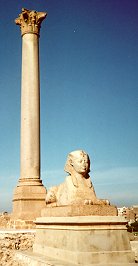
Alexandria
![]()
| Alexandria is a
Graeco-Roman city founded by
Alexander the Great on the site of an earlier
Egyptian settlement called Raqote. During the Ptolemaic
and Roman periods (c.332 BCE - CE 395)
Alexandria was a thriving cosmopolitan city. By 320 BCE it had replaced Memphis as the capital of Egypt. It was essentially a Greek rather
than an Egyptian city. In the late first century CE a Roman orator even went as far as to
describe Egypt as a mere appendage to Alexandria. It was the home of the Pharos Lighthouse, a 600-foot (180m) tower -- one of the Seven Wonders of the Ancient World and the model from which all the world's lighthouses were to be copied. By the 14th century successive earthquakes and long neglect had destroyed all traces of the Pharos tower. Other famous ancient buildings at Alexandria were the Library and the Museum which were burned down, along with an irreplaceable collection of papyri, in the third century CE. |
![]()
The Qaytbay Fort, on
the very tip of the eastern harbor, occupies the site of the ancient Pharos Lighthouse.
The medieval structure was built in the 15th century. Some masonry from the Pharos was
used in the building and can be seen. It is now a Naval Museum.
The Roman Odeon is a Graeco-Roman open-air
theatre, the only one of its kind in Egypt. It was probably built towards the end of the
2nd century CE. Twelve rows of white marble seating radiate upwards in a semi-circle.
 Pompey's Pillar, one of the surviving
monuments in Alexandria, is a red granite column erected by the Roman emperor
Diocletian in c.CE 297. Its
height, including the pedestal and Corinthian capital is 98 feet (30m).
Pompey's Pillar, one of the surviving
monuments in Alexandria, is a red granite column erected by the Roman emperor
Diocletian in c.CE 297. Its
height, including the pedestal and Corinthian capital is 98 feet (30m).
© All pictures are Copyright 1998 - 2001 Grisel Gonzalez